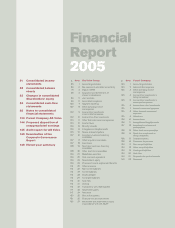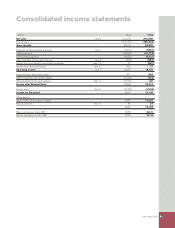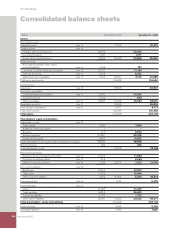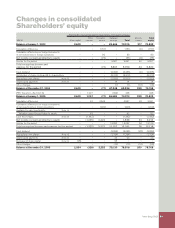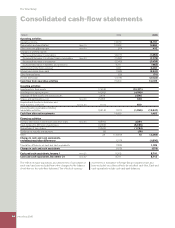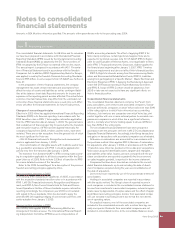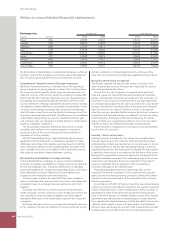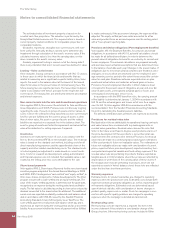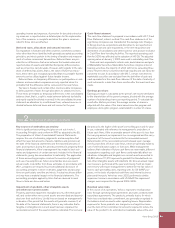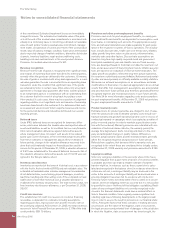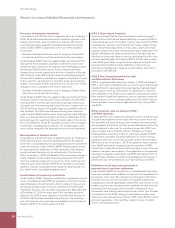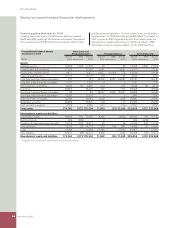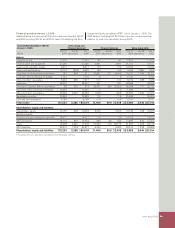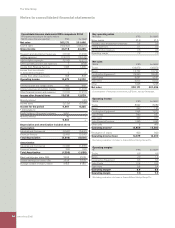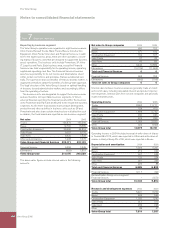Volvo 2005 Annual Report Download - page 94
Download and view the complete annual report
Please find page 94 of the 2005 Volvo annual report below. You can navigate through the pages in the report by either clicking on the pages listed below, or by using the keyword search tool below to find specific information within the annual report.
The Volvo Group
90 Volvo Group 2005
Notes to consolidated fi nancial statements
of the commitment. Estimated impairment losses are immediately
charged to income. The estimated net realizable value of the prod-
ucts at the end of the residual value commitments is monitored indi-
vidually on a continuing basis. In monitoring estimated net realizable
value of each product under a residual value commitment, manage-
ment makes consideration of current price-level of the used product
model, value of options, mileage, condition, future price deterioration
due to expected change of market conditions, alternative distribution
channels, inventory lead-time, repair and reconditioning costs,
handling costs and overhead costs in the used product divisions.
Provisions for residual value risk amount to 931.
Revenue recognition
Revenue from the sale of goods is recognized when signifi cant risks
and rewards of ownership have been transferred to external parties,
normally when the goods are delivered to the customers. If, however,
the sale of goods is combined with a buy-back agreement or a resid-
ual value guarantee, the sale is accounted for as an operating lease
transaction under the condition that signifi cant risks of the goods
are retained by Volvo. In certain cases Volvo enters into a buy-back
agreement or residual value guarantee after Volvo sold the product
to an independent party or in combination with an undertaking from
the customer that in the event of a buy-back to purchase a new
Volvo product. In such cases, there may be a question of judgement
regarding whether or not signifi cant risks and rewards of ownership
have been transferred to the customer. If it is determined that such
an assessment was incorrect, Volvo’s reported revenue and income
for the period will decline and instead be distributed over several
reporting periods.
Deferred taxes
Under IFRS, deferred taxes are recognized for temporary differ-
ences, which arise between the taxable value and reported value of
assets and liabilities as well as for unutilized tax-loss carryforwards.
Volvo records valuation allowances against deferred tax assets
where management does not expect such assets to be realized
based upon current forecasts. In the event that actual results differ
from these estimates or management adjusts these estimates in
future periods, changes in the valuation allowance may need to be
done that could materially impact our fi nancial position and the
income for the period. At December 31, 2005, a valuation allowance
of 2.972 was established for the value of deferred tax assets. Net of
this valuation allowance, deferred tax assets net of 10.216 were rec-
ognized in the Group’s balance sheet.
Inventory obsolescence
Inventories are reported at the lower of historical cost, in accordance
with the fi rst-in, fi rst-out method (FIFO), and net realizable value. The
estimated net realizable value includes management consideration
of out-dated articles, over-stocking, physical damages, inventory-
lead-time, handling and other selling costs. If the estimated net real-
izable value is lower than historical cost, a valuation allowance is
established for inventory obsolescence. The total inventory value, net
from inventory obsolescence allowance, is per December 31, 2005,
33.937.
Credit loss reserves
The establishment of credit loss reserves on customer fi nancing
receivables is dependent on estimates including assumptions
regarding past dues, repossession rates and the recovery rate on
the underlying collateral. At December 31, 2005, the total credit loss
reserves in Volvo Financial Services amounted to 2.17% of the total
credit portfolio, SEK 79 billions.
Pensions and other post-employment benefi ts
Provisions and costs for post-employment benefi ts, i.e. mainly pen-
sions and health-care benefi ts, are dependent on assumptions used
by actuaries in calculating such amounts. The appropriate assump-
tions and actuarial calculations are made separately for each popu-
lation in the respective countries of Volvo’s operations. The assump-
tions include discount rates, health care cost trends rates, infl ation,
salary growth, long-term return on plan assets, retirement rates,
mortality rates and other factors. Discount rate assumptions are
based on long-term high quality corporate bond and government
bond yields available at year-end. Health care cost trend assump-
tions are developed based on historical cost data, the near-term out-
look, and an assessment of likely long-term trends. Infl ation assump-
tions are based on an evaluation of external market indicators. The
salary growth assumptions refl ect the long-term actual experience,
the near-term outlook and assumed infl ation. Retirement and mortal-
ity rates are based primarily on offi cially available mortality statistics.
We review our actuarial assumptions on an annual basis and make
modifi cations to them when it is deemed appropriate to do so. Actual
results that differ from management’s assumptions are accumulated
and amortized over future periods and, therefore, generally affect the
recognized expense and recorded provisions in such future periods.
See Note 24 for more information regarding costs and assumptions
for post-employment benefi ts. At December 31, 2005 net provisions
for post-employment benefi ts amounted to 11.462.
Product warranty costs
Estimated costs for product warranties are charged to cost of sales
when the products are sold. Estimated warranty costs include con-
tractual warranty and goodwill warranty (warranty cover in excess of
contractual warranty or campaigns which is accepted as a matter of
policy or normal practice in order to maintain a good business rela-
tion with the customer). Warranty provisions are estimated with con-
sideration of historical claims statistics, the warranty period, the
average time-lag between faults occurring and claims to the com-
pany and anticipated changes in quality indexes. Differences
between actual warranty claims and the estimated claims generally
affect the recognized expense and provisions in future periods.
Refunds from suppliers, that decrease Volvo’s warranty costs, are
recognized to the extent these are considered to be virtually certain.
At December 31, 2005 warranty cost provisions amounted to 8.163.
Legal proceedings
Volvo only recognizes liabilities in the accounts where Volvo has a
present obligation from a past event, a transfer of economic benefi ts
is probable and Volvo can make a reliable estimate of what the
transfer might be. In instances such as these, a provision is calcu-
lated and recognized in the balance sheet. In instances where these
criteria are not met, a contingent liability may be disclosed in the
notes to the accounts. A contingent liability will be disclosed when a
possible obligation has arisen but its existence will only be con-
fi rmed by future events not wholly within Volvo’s control or in circum-
stances where an obligating event has occurred but it is not possible
to quantify the size or likelihood of that obligation crystallizing. Reali-
zation of any contingent liabilities not currently recognized or dis-
closed in the fi nancial statements could have a material effect on
Volvo’s fi nancial condition. Volvo regularly reviews signifi cant out-
standing legal cases following developments in the legal proceed-
ings in order to assess the need for provisions in our fi nancial state-
ments. Among the factors that Volvo considers in making decisions
on provisions are the nature of the litigation, claim or assessment,
the legal processes and potential level of damages in the jurisdiction
in which the litigation, claim or assessment has been brought, the


